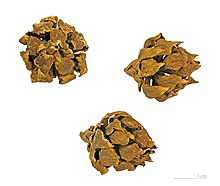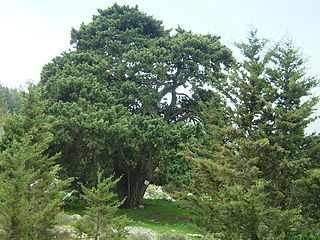
Cupressus is one of several genera of evergreen conifers within the family Cupressaceae that have the common name cypress; for the others, see cypress. It is considered a polyphyletic group. Based on genetic and morphological analysis, the genus Cupressus is found in the subfamily Cupressoideae. The common name "cypress" comes via the Old French cipres from the Latin cyparissus, which is the latinisation of the Greek κυπάρισσος (kypárissos).
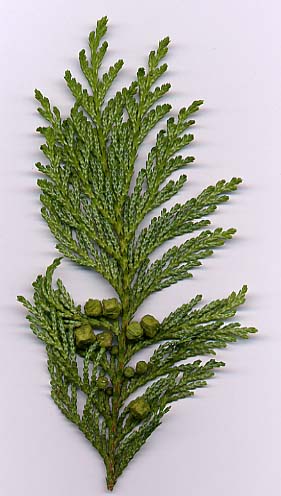
Chamaecyparis, common names cypress or false cypress, is a genus of conifers in the cypress family Cupressaceae, native to eastern Asia and to the western and eastern margins of the United States. The name is derived from the Greek khamai (χαμαί), meaning "on the earth", and kuparissos (κυπάρισσος) for "cypress".
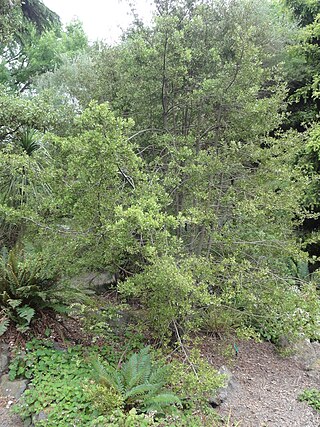
Phyllocladus, the celery pines, is a small genus of conifers, now usually placed in the family Podocarpaceae.Species occur mainly in New Zealand, Tasmania, and Malesia in the Southern Hemisphere, though P. hypophyllus ranges into the Philippines, a short way north of the equator.

Calocedrus, the incense cedar, is a genus of coniferous trees in the cypress family Cupressaceae first described as a genus in 1873. Three species are native to eastern Asia and one to western North America.
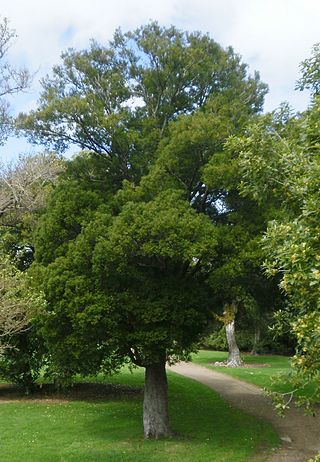
Prumnopitys is a genus of conifers belonging to the family Podocarpaceae. The nine recognized species of Prumnopitys are densely branched, dioecious evergreen trees up to 40 metres in height.

Dacrydium is a genus of conifers belonging to the podocarp family Podocarpaceae. Sixteen species of evergreen dioecious trees and shrubs are presently recognized. The genus was first described by Solander in 1786, and formerly included many more species, which were divided into sections A, B, and C by Florin in 1931. The revisions of de Laubenfels and Quinn, reclassified the former section A as the new genus Falcatifolium, divided Section C into new genera Lepidothamnus, Lagarostrobos and Halocarpus, and retained Section B as genus Dacrydium.
Falcatifolium is a genus of conifers of the family Podocarpaceae. The genus includes evergreen dioecious shrubs and large trees of up to 36 metres (118 ft). Five species are presently recognized. The genus was first described by de Laubenfels in 1969, and is composed of species formerly classified in genus Dacrydium.

Dacrycarpus is a genus of conifers belonging to the family Podocarpaceae. The genus includes nine species of dioecious evergreen trees and shrubs to 55–60 metres (180–197 ft) in height.

Halocarpus is a genus of conifers of the family Podocarpaceae. The genus includes three closely related species of evergreen trees and shrubs, all endemic to New Zealand.

Lepidothamnus is a genus of conifers belonging to the podocarp family Podocarpaceae. The genus includes three species of dioecious or monoecious evergreen trees and shrubs, and creepers. L. intermedius and L. laxifolius are native to New Zealand. L. fonkii is native to the Magellanic subpolar forests ecoregion of southern Argentina and Chile, where it grows as a low shrub or creeper in moorlands and bogs.
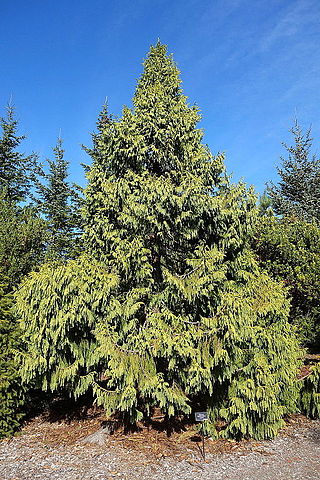
Taiwania, with the single living species Taiwania cryptomerioides, is a large coniferous tree in the cypress family Cupressaceae.
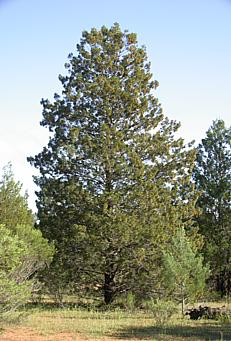
Callitris is a genus of coniferous trees in the Cupressaceae. There are 16 recognized species in the genus, of which 13 are native to Australia and the other three native to New Caledonia. Traditionally, the most widely used common name is cypress-pine, a name shared by some species of the closely related genus Actinostrobus.
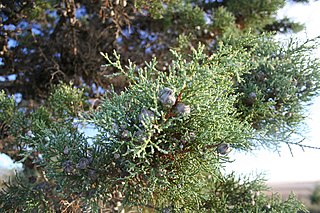
Actinostrobus is a genus of coniferous trees in the Cupressaceae. Common names include cypress, sandplain-cypress and cypress-pine, the last of these shared by the closely related genus Callitris.

Libocedrus is a genus of five species of coniferous trees in the cypress family Cupressaceae, native to New Zealand and New Caledonia. The genus is closely related to the South American genera Pilgerodendron and Austrocedrus, and the New Guinean genus Papuacedrus, both of which are included within Libocedrus by some botanists. These genera are rather similar to the Northern Hemisphere genera Calocedrus and Thuja: in earlier days, what is now Calocedrus was sometimes included in Libocedrus. They are much less closely related, as recently confirmed. The generic name means "teardrop cedar", apparently referring to drops of resin.
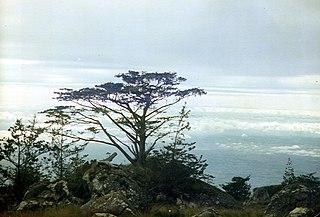
Widdringtonia is a genus of coniferous trees in the Cupressaceae. The name was Austrian botanist Stephan Endlicher's way of honouring an early expert on the coniferous forests of Spain, Capt. Samuel Edward Widdrington (1787–1856). There are four species, all native to southern Africa, where they are known as cedars or African cypresses.

Cephalotaxus, commonly called plum yew or cowtail pine, is a genus of conifers comprising 11 species, either considered the only member of the family Cephalotaxaceae, or in the Taxaceae when that family is considered in a broad sense. The genus is endemic to eastern Asia, though fossil evidence shows it had a wider Northern Hemisphere distribution in the past. The species are evergreen shrubs and small trees reaching 1.0–10 metres (3–33 ft) tall.

Amentotaxus is a genus of conifers (catkin-yews) comprising five species, treated in either the Cephalotaxaceae, or in the Taxaceae when that family is considered in a broad sense. The genus is endemic to subtropical Southeast Asia, from Taiwan west across southern China to Assam in the eastern Himalaya, and south to Vietnam. The species are evergreen shrubs and small trees reaching 2–15 m tall.
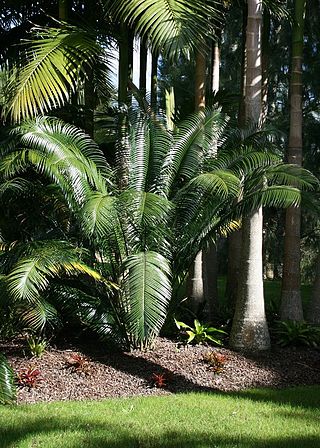
Lepidozamia is a genus of two species of cycad, both endemic to Australia. They are native to rainforest climates in eastern Queensland and eastern New South Wales. They have a diploid chromosome number of 2n = 18.

Sequoioideae, commonly referred to as Redwoods, is a subfamily of coniferous trees within the family Cupressaceae, that range in the northern hemisphere. It includes the largest and tallest trees in the world. The trees in the subfamily are amongst the most notable trees in the world and are common ornamental trees. The subfamily was dominant during the Jurassic and Cretaceous periods.

Hesperocyparis is a genus of trees in the family Cupressaceae, containing North American species otherwise assigned to the genus Cupressus. They are found throughout western North America. Only a few species have wide ranges, with most being restricted-range endemics.

